Shared posts
Inflammation links social adversity and diabetes
Gut Bacteria Allows Insect Pest to Foil Farmers
Here is a lesson that we’re going to be taught again and again in the coming years: Most animals are not just animals. They’re also collections of microbes. If you really want to understand the animal, you’re also have to understand the world of microbes inside them. In other words, zoology is ecology.
Consider the western corn rootworm—a beetle that’s a serious pest of corn in the US. The adults have strong preferences for laying eggs in corn fields, so that their underground larvae hatch into a feast of corn roots. This life cycle depends on a continuous year-on-year supply of corn. Farmers can use this dependency against the rootworm, by planting soybean and corn in alternate years. These rotations mean that rootworms lay eggs into corn fields but their larvae hatch among soybean, and die.
But the rootworms have adapted to this strategy by reducing their strong instincts for laying eggs in corn. These ‘rotation-resistant’ females might lay among soybean fields, so their larvae hatch into a crop of corn.
There are almost certainly genetic differences that separate the rotation-resistant rootworms from their normal peers, but what are they? Researchers at the University of Illinois have been studying the problem since 2000 and, despite generating a vast mountain of data, have failed to find the genes in question. “The western corn rootworm has been an enigma for long time,” says Manfredo Seufferheld. “This insect has the ability to adapt to practically all control methods deployed against it, including crop rotation. After many years of research about the mechanisms of rotation resistance, results were mostly inconclusive.”
So, Seufferheld looked elsewhere. Rather than focusing on the rootworm’s own genes, he studied the genes of the bacteria in its gut… and found some answers. The rotation-resistant varieties have very different gut bacteria to the normal ones. And when the team killed these microbes with antibiotics, they severely reduced the beetle’s ability to cope with rotation.
“The bad guy in the story—the western corn rootworm—was actually part of a multi-species conspiracy,” says Joe Spencer, who was part of the study. “No wonder it was hard to figure out what was happening. We were only looking at the most obvious aspects of the story.”
The team, including graduate student Chia-Ching Chu, found that a third of the rootworms’ gut bacteria comprise species that are unique to either the resistant or normal varieties (the green and gray groups in the diagram below). These two factions also differ in the relative numbers of the bacteria that they share (compare the orange and blue groups).
These changing microbes give the resistant beetles an edge when eating soybean. The rootworms digest the protein in their meals using enzymes called cysteine proteases, and soybeans defend themselves with substances that can block these enzymes. But Chu found that the more the beetles’ bacteria differed most from the ‘normal’ set, the higher the levels of cysteine proteases in their guts. By avoiding indigestion, these beetles were better at surviving among soybeans, and more likely to lay their eggs there. Across the US Corn Belt, there’s a gradient of gut microbes that affect how well the beetles cope with our farming practices.
The team proved that the bacteria were responsible by killed them with antibiotics. Sure enough, this drastically lowered the cysteine protease activity in the guts of the rotation-resistant beetles (but not the normal ones) and wrecked their ability to thrive among soybeans.
So, if you really want to understand the animal, you’re also have to understand the microbes. The rootworm’s gut bacteria are effectively another one of its organs, but an astonishingly flexible one that can change dramatically when exposed to a new food source. This allows the insects to adapt very quickly to environmental challenges, far more quickly than if they could only rely on mutations in their own genes.
The bacteria are certainly part of the rotation-resistance puzzle, but it’s not clear how big their role is. Seufferheld still wants to know how the insect’s own genes affect their ability to live among soybean, how they control the bacterial communities in their guts, and how those different communities emerge in the first place.
Such studies might give us clues about how to control the rootworm. Spraying fields with antibiotics is out of the question—these drugs have already been heavily misused in agriculture to the detriment of our own health. “I don’t think we’ll be crop-dusting western corn rootworms to manage their adaptable gut microbes,” says Spencer. “I do think we need consider how those microbes might interact with our pest management tactics.”
He adds, “Modern agriculture has always underestimated the ability of pests to circumvent pest control, and I think the realization that pest insects are not alone in their efforts should give us some pause. There is a brand new tiny world out there inside every creature, and we need to start thinking seriously about it.”
Reference: Chua, Spencer, Curzi, Zavala & Seufferheld. 2013. Gut bacteria facilitate adaptation to crop rotation in the western corn rootworm. PNAS http://dx.doi.org/10.1073/pnas.1301886110
When green algae run out of air: Single cell organisms need haemoglobin to survive in an oxygen-free environment
Groupers Use Gestures to Recruit Morays For Hunting Team-Ups
The giant moray eel can grow to three metres in length and bites its prey with two sets of jaws—the obvious ones and a second set in its throat that can be launched forward like Hollywood’s Alien. It’s not a creature to be trifled with. But the coral grouper not only seeks out giant morays, but actively rouses them by vigorously shaking its body. The move is a call to arms that tells the moray to join the grouper in a hunt.
The two fish cooperate to flush out their prey. The grouper’s bursts of speed make it deadly in open water, while the moray’s sinuous body can flush out prey in cracks and crevices. When they hunt at the same time, prey fish have nowhere to flee.
Redouan Bshary from the University of Neuchatel in Switzerland discovered this partnership in 2006. He usually studies cleaner wrasse, which pick parasites off larger fish. When tracking groupers to see if they patronised several cleaners, Bshary noticed one of them rousing a moray. They also team up with the humphead wrasse—a huge human-sized fish whose extensible jaws can suck prey out from cracks. It too complements the grouper’s open-water skills.
Bshary was fastidious in recording his grouper observations—all 187 hours of them. He also took several films and when Alexander Vail from the University of Cambridge watched them, he noticed something Bshary had missed. The groupers always summoned the wrasses and morays with a vigorous shimmy, but they also used a second, much rarer signal—a headstand, combined with head-shaking. Vail thinks it was a signal, one that said: “The prey’s in here, guys!”
When doing their headstands, the groupers always swam over the location of hidden prey that they had failed to catch. They only used the move when a moray or wrasse was nearby, continued to do so until one arrived, and stopped as soon as one did.
Most morays and all wrasses headed towards the grouper’s location when they saw the signal, causing the prey to break their cover. (The fact that the prey didn’t abandon their hiding spots beforehand shows that the headstand itself isn’t a hunting tactic.) And when the morays ignored the headstand, the groupers actually swum after their partner and either performed their “recruitment shimmy” or forcibly tried to push the eels in the right direction.
To Vail, the headstand has all the hallmarks of an attention-grabbing “referential gesture”, like a human pointing at an object. It’s directed at a ‘listener’, draws attention to an object of interest, triggers a response, and has no other purpose beyond being a signal. It also seems like something the grouper intends to do, rather than a random movement that coincidentally summons a moray—after all, if the signal doesn’t work, the grouper gives up and attracts the eel through other means.
The team also found that another reef fish—the coral trout—uses the same signal to team up with octopuses! The partners have the same set of complementary skills as the grouper and moray—the trout chases exposed prey and the octopus grabs hidden ones.
If this really is a referential gesture, that’s an important discovery. Such gestures are part and parcel of human life, but the only animals that seem to use them are intelligent ones, like chimps and other great apes, ravens, dolphins, and domestic dogs. In fact, the discovery of gestures in ravens was taken as further evidence of their impressive mental abilities.
But Vail and Bshary believe that intelligence is a red herring. The grouper and trout use gestures, and while they may be more intelligent than we give them credit for, it’s very unlikely that they rival apes. Instead, they evolved to use gestures simply because they benefit from coordinated cooperation with other species. Their gestures are driven by needs not smarts. They remind us once again that complex behaviour doesn’t necessarily imply complex minds.
Reference: Vail, Manica & Bshary. 2013. Referential gestures in fish collaborative hunting. Nature Communications. http://dx.doi.org/10.1038/ncomms2781
Mary Anne Hitt: Moapa to Lead Powerful, Symbolic Walk from Coal to Clean Energy
Southern Nevada's Moapa Band of Paiutes are organizing a 16-mile "Walk from Coal to Clean Energy" on April 20, 2013 in concert with Earth Day. This walk will celebrate the tribe's efforts to retire the polluting Reid Gardner coal plant that adjoins their tribal lands, and also their success in developing the largest solar project on tribal lands in the nation, which will begin construction later this year. The walk will start at the coal plant and end at the solar site - a powerful symbol of change for Nevada and the nation.
The Moapa and a broad coalition of environmental and community groups in Nevada have been pushing to retire NV Energy's Reid Gardner coal plant for many years. A recent announcement by NV Energy CEO Michael Yackira that the company wants to retire its coal plants and contracts early and replace them with renewable energy and natural gas power is a key milepost in the decades-long struggle of the Moapa for environmental justice.
"Coal is a fuel of the past in our state" - that's how Yackira put it, in a recent interview discussing the announcement. The company has drafted legislation to be considered by the Nevada legislature that would allow the coal plant retirements.
So on Earth Day, tribal leaders and members, as well as other tribes from the region, will walk 16 miles starting at sunup and arriving at the solar plant site by mid-afternoon. Environmental activists and other community supporters will meet them to rally and celebrate this important milestone in their campaign, and to call for the expansion of more renewable energy like solar, wind, and geothermal for Nevada's clean energy future.
Grassroots supporters from throughout southern Nevada will meet at a location 1.5 miles from the rally site (about 40 miles northeast of Las Vegas) and walk to the site. The rally will feature a drum circle and several speakers including William Anderson, Chairman of the Tribal Council, and Allison Chin, President of the Sierra Club. It will conclude with a round dance by the Moapa Band of Paiutes.
The Reid Gardner coal plant is located directly adjacent to the tribal community, only a few hundred feet from the nearest homes. Built beginning in the 1960s, it is a source of serious air and water contamination. Over the decades the Moapa have experienced many health problems that are likely related to the plant, including very high rates of asthma, heart disease and cancer.
The Moapa were featured in Sierra magazine's recent "Cost of Coal" series, too.
The Moapa and other organizations like the Sierra Club and the Nevada Clean Energy Campaign are hopeful that NV Energy's change in strategy will ultimately lead to a just, fair and environmentally sound resolution to close the Reid Gardner plant and move Nevada quickly to a clean energy future.
The city of Los Angeles has already agreed to purchase the energy from the Moapa solar project, as part of the city's commitment to move beyond coal, announced just last month by L.A. Mayor Antonio Villaraigosa, Al Gore, Sierra Club Executive Director Michael Brune, and others. We look forward to keeping the clean energy momentum rolling with this powerful, symbolic march.
For more information about the "Walk from Coal to Clean Energy" on April 20, please contact Sierra Club Organizer Elspeth DiMarzio at (702) 732-7750 or elspeth.cordua@sierraclub.org. Second photo by Craig Rock.
Julie Brothers: Farm to Fork Across America: 'Farming Beyond Me... Fighting the Tide in a Sea of Wheat'
Co-Authored by Lee Glenn
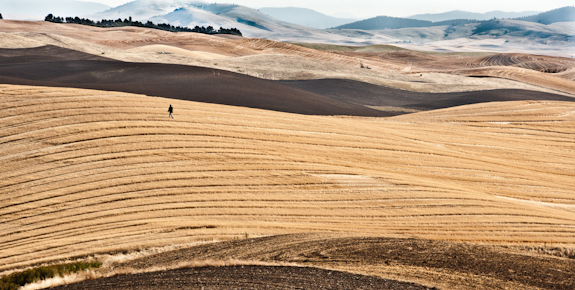
Entering The Palouse, east of everything in Washington state, we crossed an invisible barrier where dunes suddenly appear. A hypnotic place, breathtaking, but not because of dunes of sand... it's the Sahara Desert rendered in wheat. Every curve frames another wave of wheat-dunes within wheat-dunes, stretching as far as the eye can see, bathed in the last rays of light kissing the tips of the freshly harvested crop.
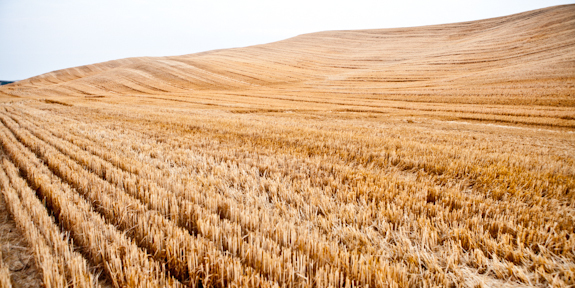
A photographer's dream-scape, we stop the car repeatedly to capture the exquisite vastness. We also realize an unforgettable stillness, a surround-sound of no sound. The scene becomes unreal as the sunlight fades and is replaced by the moon. The air itself... breathless.
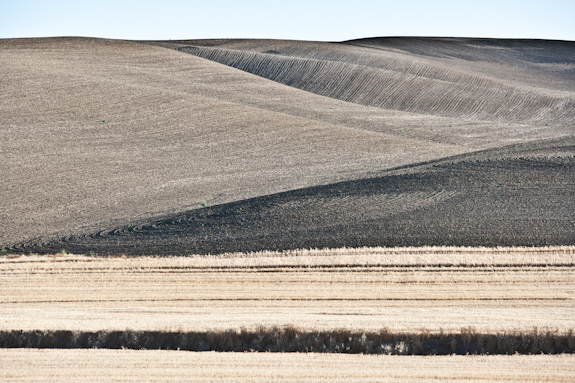
Adjacent to the road is a 360 degree mono-crop panorama, glorious in its visual character, frightening in the sprawl of its ecological impact. Stripped bare of life except for the beheaded wheat stalks, is an unrequited balance between industrial farming and the natural world.
Lee brought us here for the scenography discovered on motorcycle trips, but we've also discovered the Zakarison Partnership, a 1200 acre family farm in a region dominated by 16,000 - 20,000 acre industrial farms. Eric and Sheryl Zakarison are causing a stir with their commitment to transforming the business from conventional to organic.
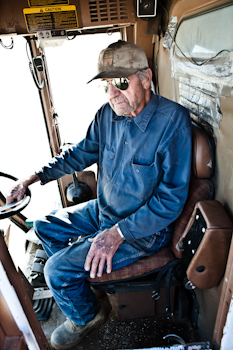 The Zakarison's have worked their wheat fields with patriarch Russell, since the farm's founding in 1935. Though sympathetic to his father's struggles, progress and success, Eric has a different vision...one of an ecologically sound legacy. His goal is to re-establish the health of his land, to "pass through" the health of the soil to the health of his family, to "pass on" the land's wealth through its vitality.
The Zakarison's have worked their wheat fields with patriarch Russell, since the farm's founding in 1935. Though sympathetic to his father's struggles, progress and success, Eric has a different vision...one of an ecologically sound legacy. His goal is to re-establish the health of his land, to "pass through" the health of the soil to the health of his family, to "pass on" the land's wealth through its vitality.
"My goal for the next generation is to leave them with a system where they can still be successful raising food," Eric explains.
Eric's desire grows from his pessimistic opinion of the industrial based systems that dominate The Palouse. "We turn oil into food," he notes, "I can't see the industrial system holding up over time as we reach peak oil. How will the farmers power all those big toys...everything comes to us on a truck. The locals don't want to talk about it; they look down at their shoes if the subject comes up."
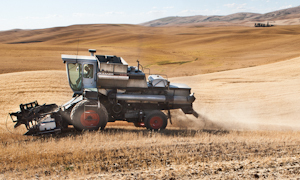 His answer: transforming the farm by producing food with less energy input. For Eric, this starts with selling locally. While 85% of the soft white wheat produced in The Palouse is shipped to Asia, Eric's barley is marketed to small farms in the region. He also sells grain locally for feed, as well as poultry, eggs and lamb. Sustainability = local = economical in this case as his feed only costs 10 cents/bushel for transportation vs. 50 cents/bushel to ship to Portland.
His answer: transforming the farm by producing food with less energy input. For Eric, this starts with selling locally. While 85% of the soft white wheat produced in The Palouse is shipped to Asia, Eric's barley is marketed to small farms in the region. He also sells grain locally for feed, as well as poultry, eggs and lamb. Sustainability = local = economical in this case as his feed only costs 10 cents/bushel for transportation vs. 50 cents/bushel to ship to Portland.
Five years ago, Eric & Sheryl began a phased conversion of a portion of the farm to organics. Critical to success was restoring the health of the soil through a five to eight year rotation of crops instead of the typical three-year rotation.
"Our rotation could include a perennial legume like alfalfa for guarantied coverage, grain crops without herbicides, a green manure crop, then another grain crop, then start over. I expect it to take four to five years to restore the lost fertility in the soil."
This conversion is part of a study directed by John Reganold of Washington State University and is partially funded by a USDA grant supporting organic transition. Eric is also eying a 175 acre section that has been in a Conservation Reserve Program for a number of years. "As this property comes out of conservation, it is a good candidate for an organic approach because no chemicals have been used on it for 15 years," he explains.
Fascinated by The Palouse Prairie region, we needed to know how this landscape came to be and how it came to be so thoroughly exploited.
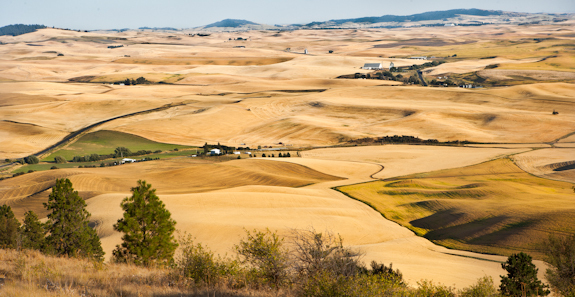
"The Palouse is a dry steppe climate," Eric explains. "With 21-22 inches of rainfall a year and no irrigation for large-scale vegetable production, a grass and grain based system was a natural fit. In the early 1900's, there was more diversity including pastures for draft animals, but consolidations and government policies created large-scale industrial farming after WWII."
"During the depression, the family almost lost the farm, but after the war petrochemical fertilizers and pesticides were miracles that increased productivity and made The Palouse one of the largest providers of dry-land wheat."
Coming from this cultural/economic background and after farming for 77 years, Russell Zakarison is "...bemused by going organic."
Eric believes that the industrial farmers are challenged by small organic farmers. He feels this with only one local farmer as a customer for pasture raised poultry. Their petrochemical over-spray also makes it difficult to prevent inadvertent contamination.
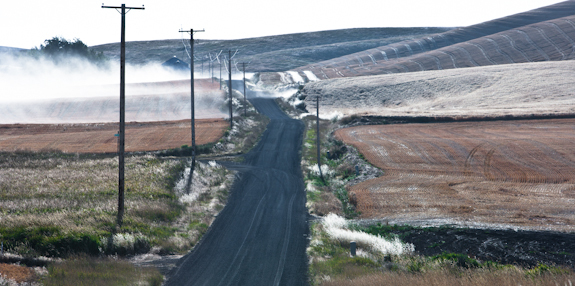
For over 60 years, the chronic use of inorganic fertilizers and chemicals has poisoned the Palouse's eco-system food chain. This has far reaching impact as toxic soil runoff spreads through the Columbia River watershed. The extensive industrial farming has caused other adverse effects such as loss of topsoil and erosion.
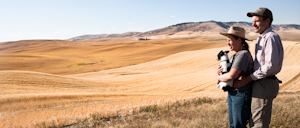 In their own grass-roots way, the Zakarison's are agents of change in this vast landscape.
In their own grass-roots way, the Zakarison's are agents of change in this vast landscape.
Two to three decades are their timeframe to make the transition.
Eric's simple motto says it all: "farming beyond me," are the watchwords he lives by.
